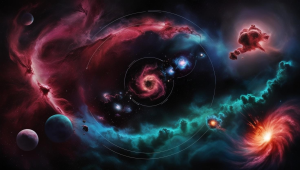
WORMHOLES:COSMIC SHORTCUTS
What if you could rocket from Earth, not to the Moon or Mars, but down a wormhole that loops all the way across the vast Milky Way, slashing travel time
Space travel, once a dream reserved for science fiction, is becoming a rapidly evolving field, fueled by breakthroughs in technology, a growing interest in commercial space ventures, and humanity’s desire to explore beyond Earth. From space tourism to interplanetary exploration, the future of space travel promises to revolutionize how we interact with the cosmos. However, significant technological, financial, and logistical challenges must be addressed to make this future a reality. In this article, we will explore the current state of space travel, emerging technologies, and the challenges that must be overcome to ensure the success of future missions.
Technological advancement that is defining the current landscape in space travel
Innovation in modern space transportation has seen probably the largest growth in the use of rockets that can be reused. Normal rockets are used once and then disposed of so space exploration becomes expensive. However, today, firms such as SpaceX have developed rocket reusability, making it tremendously cheaper to send objects to space. The objectifiable stipulation will, for instance, show how the Falcon 9 rocket that conveys payload to space can be reused by landing back on earth thus reducing the costs by up to 30%as noted in the case above.
It was this advancement that has enabled more often and cheap space flights for governments and private organizations. One of the major costs in space travel is still the vehicles themselves and ways to reuse them will help ensure large-scale access to space is viable in the future.
Onerous travel is no more science fiction but it is limited to mere wealthy people. The most known commercial space tourism providers are the companies such as Blue Origin, SpaceX and Virgin Galactic. Virgin Galactic uses a suborbital spaceplane known as VSS Unity, which enables passengers to float, and see the Earth’s circumference. This is where Blue Origin’s New Shepard rocket comes in, offering the same sort of trip, albeit slightly longer, SpaceX’s Crew Dragon will be targeting similar experiences though will offer some lunar flybys.
For now, these kinds of experiences are available only to those who can buy them and spend hundreds of thousands of dollars, but reusable rockets, and competition in the private space sector will likely lower the price of space tourism after several decades.
The Artemis program of NASA is a major move to prepare for the return to the Moon and longer, preparing to send humans to Mars. Through the use of SLS and Orion spacecraft NASA intends to create sustainable lunar presence well into the final years of this decade. It will become the proving ground for technologies and life support systems mission crucial to Mars exploration.
Private companies are also working toward human space exploration goals. SpaceX’s Starship, a fully reusable spacecraft designed for deep space missions, is intended to carry large numbers of passengers and cargo to destinations like the Moon, Mars, and beyond. Starship’s successful development could make interplanetary travel a possibility within a few decades.
About the obstacles that the future of space travel may encounter
Radiation is definitely one of the most complicated problems, most vital for long- term missions, for example, Martian missions. Space travelers are subjected to two main sources of radiation: Increase in ultraviolet solar radiation and ionizing energy cosmic rays. Exposed to the space environment that covers Earth and blocked from dangerous cosmic radiations by Earth’s magnetic shield, an astronaut is a cancer, radiation sickness or any other sickness away.
Currently space agencies are researching possible solutions, ranging from better shielding to medical treatments that reduce radiation harm and it is seen as one of the big questions that need to be answered before man can safely travel off the Earth.
Indeed, survival of mankind in such conditions is another big problem to be faced during space missions in the future. A long duration mission for instance, a mission to Mars may take between several months or years. At this time astronauts are going to have to have a steady food, water, and oxygen source. Composed waste management and recycling as practiced on ISS will have to be enhanced in durability and size for the next missions.
NASA and other space agencies are still studying bioregenerative life-support systems, where the basic needs of life such as oxygen and food and water are created using natural plants and processes respectively. Extendable life-support systems and arrangements will become significant necessary facilities for planetary habitats and colonization.
Propulsion technologies available in the current world are suitable to get to and from orbit, or to go to the Moon, but not for interplanetary travel. The problem of travel to distant destinations such as Mars, let alone other celestial bodies and systems, requires faster modes of propulsion.
Ion propulsion might represent one of the most promising technologies, as it exercises electrically charged particles to develop thrust. Although ion engines are a bit slower to get started they use a meager amount of fuel which makes them perfect for lengthy space voyages. This is a technology that has seen practical application in NASA Dawn mission to the asteroid belt. Besides, Nuclear Thermal Propulsion is under consideration as possible means to reduce travel time between to planetary systems by several orders of magnitude by using nuclear reactions for thrust.
The issue of space flight cost has also not been addressed due to the very high unit costs of launching even reusable rockets, for instance, are still in the tens of millions of dollars. Now, in order to make space tourism and interplanetary missions common practice, the costs have to be cut down even more significantly.
Space tourism has also become more popular and many government bodies and space companies are looking for more efficient transit to put humans into space, cheaper rockets or spaceships, and in-space manufacturing and resources to be used for travel. Such an example as mining water and metals or other valuable materials from space rocks or the Moon could help eliminate the need for many products to be shipped from Earth, greatly decreasing costs.
A future long term space mission will not only require morale, endurance, and fortitude but also psychological and social endurance. Future astronauts for an extended journey, such as for Mars, shall be confined on board the spacecraft for many years with few possibilities of getting in touch with the earth or possibilities of any immediate rescue. Long-term isolation, confinement, and separation from home can lead to many mental problems such as depression, anxiety, anger and interpersonal troubles.
Organizations like NASA for example, are conducting research on how psychological effects can be prevented through programmes such as the HI-SEAS under which participants live in isolation in order to mimic life on Mars. It is these psychological challenges that have to be overcome for future missions to space.
Conclusion: The Path Forward
The future of space travel is bright and bleak at the same time. We are now on the brink of a new space age from reusable rocket boosters to low-cost space tourism. However, there are many unresolved issues today, namely radiation risks, emotional stress for long-term space flights. As a result it is necessary to maintain further investment in research and development of the relevant technologies, cooperation between private and public sectors, and international collaboration.
As we push the boundaries of space travel, one thing is certain: the need to explore outer space will spur development of solutions that will make it possible to explore space while at the same time enhancing life on earth, as various developments made towards space exploration have spinoff effects when used in other areas. Space travel hasn’t been easy and there remains a lot of potential for its development, someday man will colonize the stars.

What if you could rocket from Earth, not to the Moon or Mars, but down a wormhole that loops all the way across the vast Milky Way, slashing travel time

If you go outdoors on a clear evening and also search for it, you might have the ability to see Jupiter beaming brilliantly amongst the celebrities. At the exact same

Stars, the dazzling points of light that fill up the evening skies are the foundation of galaxies plus the cradles of life itself. From their birth in large clouds of

In the mission to recognize deep space mankind has actually developed progressively effective devices to observe deep space. Completion of this venture is the Extremely Large Telescope (ELT) which is

Space debris, also known as space junk, refers to the defunct artificial objects orbiting Earth. These objects include decommissioned satellites, spent rocket stages, and fragments from collisions and explosions.

The search for exoplanets– planets that orbit stars outside our planetary system– has actually quickly developed into one of the most interesting and dynamic fields of astronomy
Write to
Jasmine Gogoi at csr@scientifictemperament.com
Let’s develop our society with a scientific heart. Join us to build the scientifically nurtured future →